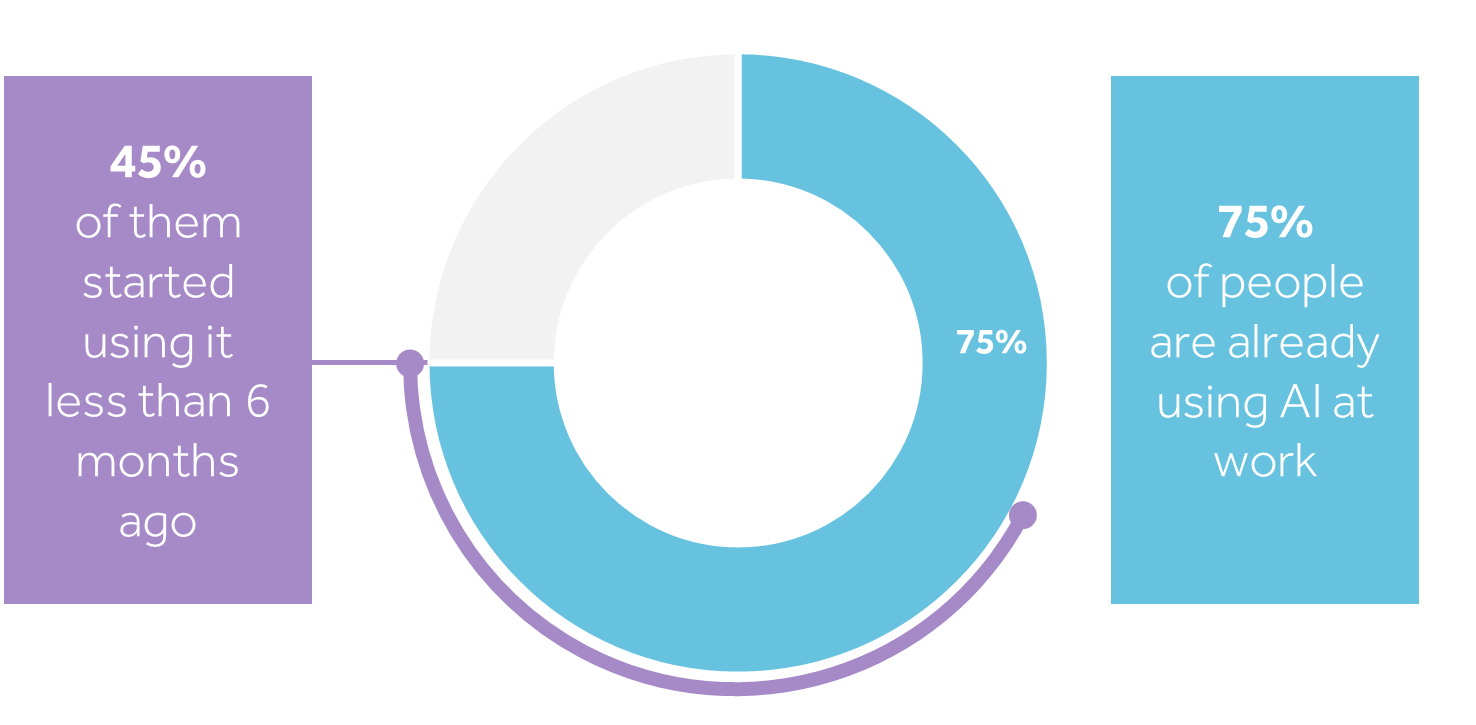
Introduction
AI is transforming the fabric of business at a rapid pace, and one of the most profound changes is how it reshapes organizational structures. The impact is so deep and prevalent that it’s no longer a question of *if* AI will alter your org chart, but *how* and *to what extent*.
Three Out of Four People Use AI at Work, and Usage Nearly Doubled in Last Six Months
 One of the findings from the 2024 Work Trend Index Report is that employees want AI at work—and they won’t wait for companies to catch up.
One of the findings from the 2024 Work Trend Index Report is that employees want AI at work—and they won’t wait for companies to catch up.
Let’s Break Down the Key Shifts and How Organizations Should Adapt
-
Flattening of Hierarchies
Traditional organizational hierarchies are already under strain, and AI is accelerating their transformation. In an age where AI can handle data processing, routine decision-making, and even strategic forecasting, the layers of middle management begin to thin out.
Think about it: AI algorithms can now perform complex analytics that would take teams of analysts weeks to complete. This does not just speed up processes; it fundamentally changes the value proposition of having large, multi-layered teams. Organizations need to shift towards flatter structures that emphasize agility, where decision-making is decentralized and faster.
Companies like Careem, the Dubai-based ride-hailing service, have embraced this shift. Careem has integrated AI to optimize its operations, from route planning to customer service, reducing the need for extensive managerial oversight. By leveraging AI, Careem has managed to create a more agile and responsive organizational structure, enabling faster decision-making through continuous automation at scale.
-
Rise of Hybrid Teams
Another significant shift is the emergence of hybrid teams—where human intelligence and AI work hand-in-hand. In these teams, AI handles tasks that are repetitive or data-intensive, freeing up human workers to focus on creative, strategic, and relationship-based work. Consider this: a Gartner survey of 105 HR leaders in June 2023 revealed that 76% believe their organizations will fall behind if they do not adopt and implement generative AI within the next 12 to 24 months. The message is clear—AI is not just a competitive edge; it is becoming a baseline for organizational success. If you are not on board, you are already playing catch-up.
This means that job roles themselves are transforming. For example, a marketing team might use AI to analyze consumer data and predict trends, while human marketers focus on crafting compelling narratives and brand stories. The symbiosis between human intuition and machine precision is already driving unprecedented levels of productivity and innovation.
Let us look at a real-world example. Emirates NBD, a leading bank in the Middle East, has successfully implemented hybrid teams to revolutionize their customer service. AI-driven chatbots manage routine inquiries and transactions, providing instant responses and efficient service. Meanwhile, human representatives are free to tackle more complex issues and develop deeper relationships with clients.
This blend of AI and human intelligence is not merely a technical upgrade; it is a strategic shift that enhances both efficiency and customer satisfaction. AI handles the volume, while humans handle the nuance. The result? A superior customer experience and a more agile organization.
Moreover, hybrid teams foster a culture of continuous improvement. As AI systems learn and evolve, they provide insights and recommendations that humans can use to refine strategies and processes. This feedback loop drives ongoing innovation and improvement, keeping organizations at the forefront.
-
Need for AI Leadership
With AI’s pervasive role, there is a growing demand for leaders who understand AI’s capabilities and limitations. It’s not enough to have a Chief Technology Officer (CTO); organizations increasingly need a Chief AI Officer (CAIO) or similar role dedicated to integrating AI into every facet of the business.
In the absence of a dedicated AI executive, the task of AI implementation in an organization inevitably lands on the desk of the CTO / IT teams. This is not just an add-on to their existing workload; it’s a monumental shift that requires them to divert their focus from other critical responsibilities. Essentially, they are forced into an ad hoc crash course on a technology that’s reshaping industries at breakneck speed.
Moreover, the ability to analyze risks and refine strategy from the top down is crucial, especially during the pilot stages of adopting a transformative modern technology. Without this focused expertise, orgs risk stumbling through their AI journey, missing opportunities and exposing themselves to avoidable pitfalls. The bottom line? If you are serious about integrating AI, you need someone at the helm who lives and breathes this stuff—because your CTO already has a full plate.
These leaders must have a deep understanding of both the technology and the business, ensuring that AI initiatives align with overall strategic goals. Moreover, they need to be adept at weaving disparate data sources while navigating security considerations, data privacy issues, and the potential for bias/misinformation in AI systems.
Consider SAP, which appointed its first Chief AI Officer (CAIO) and simultaneously launched a new AI-focused business unit. This strategic move underscores the importance of having dedicated leadership to steer AI efforts, ensuring they are tightly woven into the fabric of the company’s strategic direction.
It is no longer a ‘good-to-have’ proposition to have data speak by transcending the organizational silos, but a ‘must-have’ for orgs looking for return-on-investment with AI.
-
Redefining Skill Sets
The skill sets that organizations value are also evolving. Technical ability in AI and machine learning is becoming crucial, but so are soft skills like adaptability and complex problem-solving. The workforce of the future needs to be comfortable working alongside AI, using it to augment their capabilities.
Training and development programs must be overhauled to focus not just on AI literacy but on fostering these complementary skills. Companies are already investing heavily in reskilling their employees, recognizing that a one-time education is no longer sufficient in a rapidly evolving technological landscape.
Consider Saudi Aramco, the state-owned oil giant. Recognizing the importance of both technical and soft skills, Aramco has launched extensive training programs focused on AI and machine learning, as well as leadership development and problem-solving workshops.
Similarly, JPMorgan Chase introduced an AI training program for new hires. This program is designed to optimize productivity across sectors within the bank, projecting AI’s contribution to exceed USD 1 billion. Developers, operations staff, and call-center employees stand to benefit significantly from this initiative, illustrating how integrating AI into training programs can drive substantial operational enhancements and prepare employees for the future of work.
-
Cultural Shift
Finally, embracing AI at the organizational level requires a significant cultural shift. Companies need to foster a culture of innovation and experimentation, where failure is seen as a stepping stone to success rather than a career-ending mistake. This cultural shift is perhaps the most challenging aspect, as it requires changing mindsets at all levels of the organization.
Leaders must champion this shift, creating an environment where employees feel empowered to explore new ideas and leverage AI tools without fear. This means fostering a culture of continuous learning, where staying ahead of technological trends is a shared responsibility.
A prime example is the Dubai Electricity and Water Authority (DEWA). DEWA undertook a cultural transformation to integrate AI into its operations and promote innovation. The organization launched several initiatives to embed AI and foster a forward-thinking mindset among its employees.
DEWA’s AI program, “Digital DEWA,” is part of its broader strategy to transform Dubai into a smart city. This initiative encourages employees to experiment with AI-driven solutions to improve operational efficiency and customer service. DEWA has set up the “Moro Hub,” a state-of-the-art digital command center that leverages AI to monitor and manage utility services in real-time.
To support this cultural shift, DEWA has invested heavily in training and development programs focused on AI and digital technologies. The organization has created platforms for employees to share ideas, collaborate on innovative projects, and learn from both successes and failures.
This has put DEWA at the forefront in customer service with 100% of customer complaints resolved in 2023. Also, DEWA’s Customer Care Centre set service quality level of ~97% while keeping an average speed of answering calls in ~13 seconds.
This open culture of experimentation is crucial for fostering innovation and keeping the organization at the forefront of technological advancement.
The Path Forward
The age of AI-fueled productivity is upon us, and it demands a radical rethinking of organizational structures. Hierarchies are flattening, hybrid teams are emerging, new leadership roles are being created, skill sets are evolving, and cultural shifts are necessary. Companies that can navigate these changes effectively will be the ones that not only survive but thrive in the AI-driven world.
The key takeaway? Embrace the change, do not resist it. Organizations that cling to outdated structures and mindsets will find themselves left behind, while those that adapt will unlock new levels of productivity and innovation. The future of work is here, and it is powered by AI. Are you ready?
References
- Microsoft (2024)
- Forbes (2024)
- Financial Times (2024)
- Smart Water Magazine (2024)
- STC (2024)
- Gulf News (2024)
- Gartner (2023)
- McKinsey & Company (2023)
- TechCrunch (2023)
- Forbes (2023)
- Aramco (2022)
- McKinsey & Company (2022)




